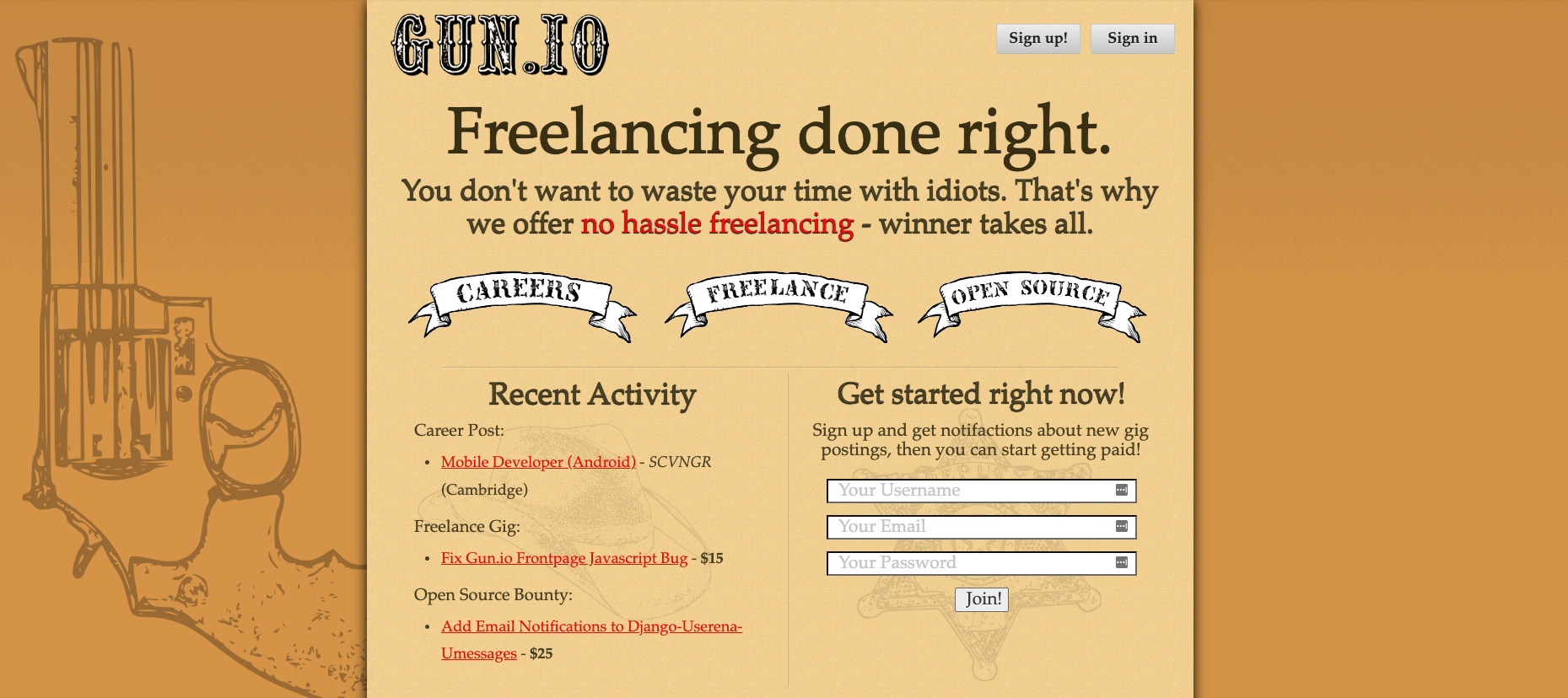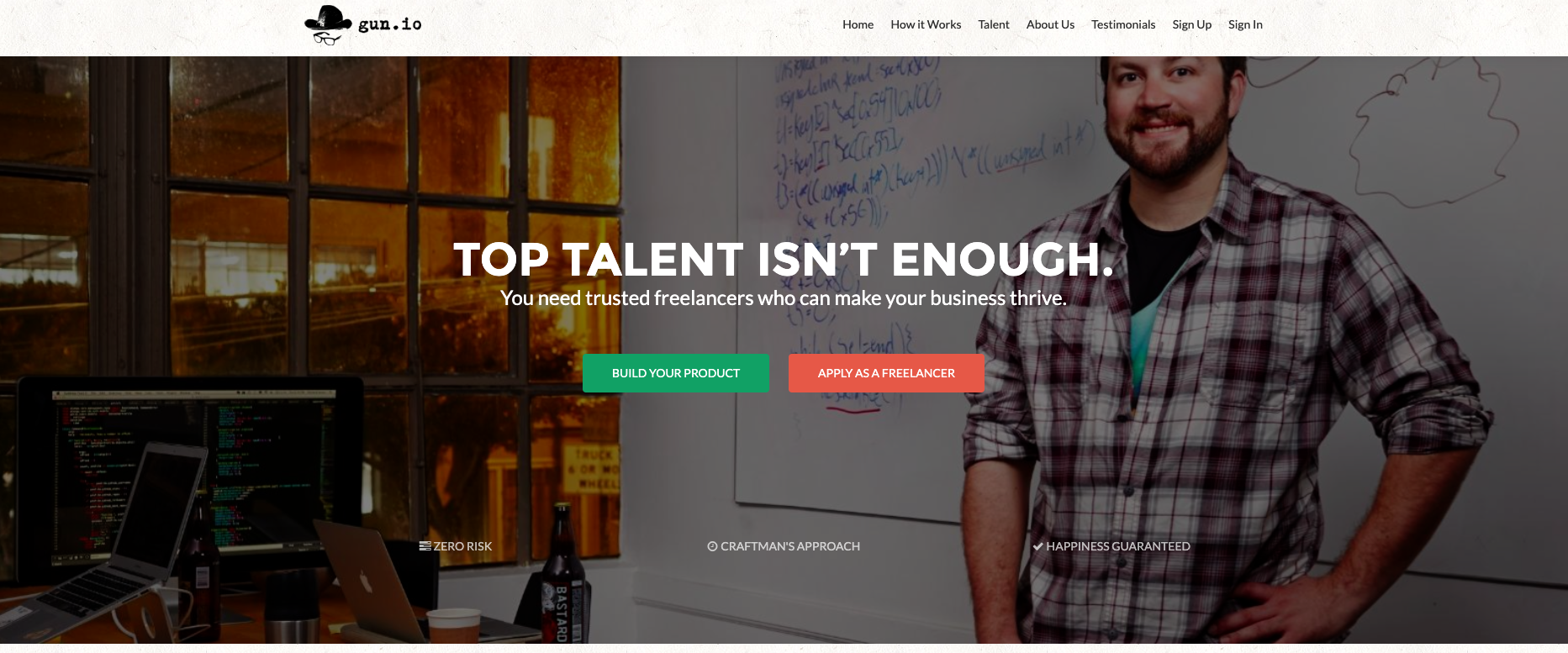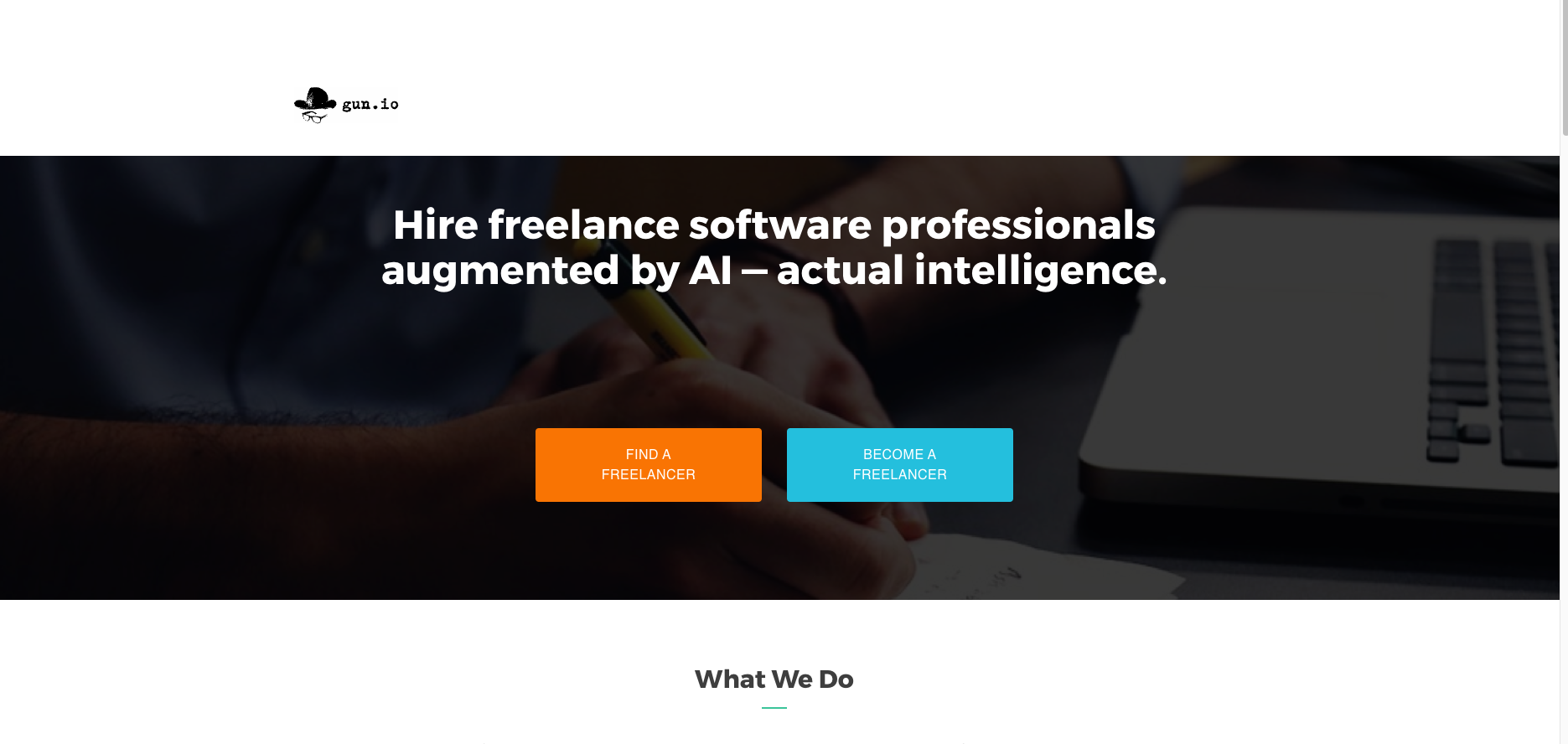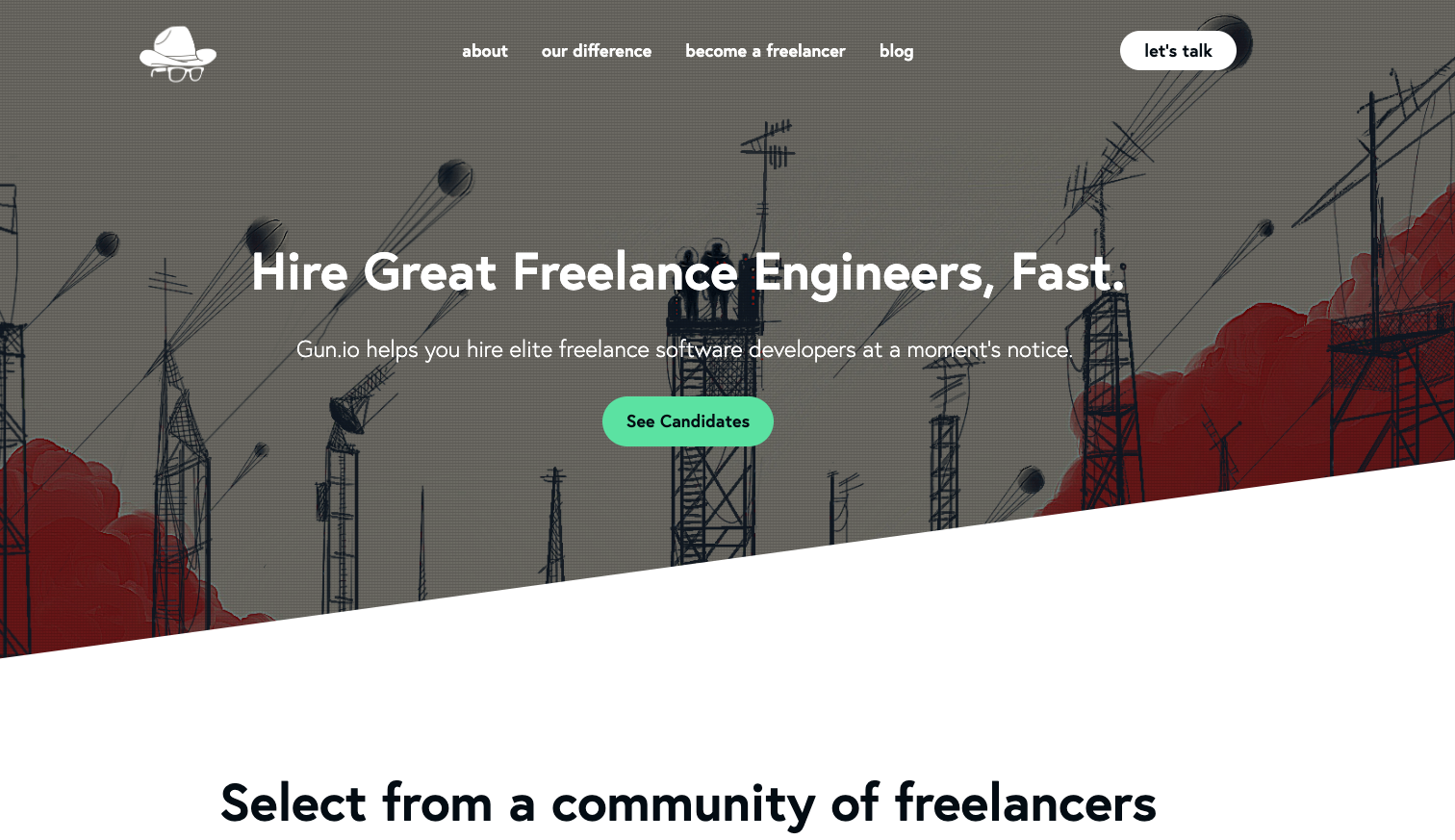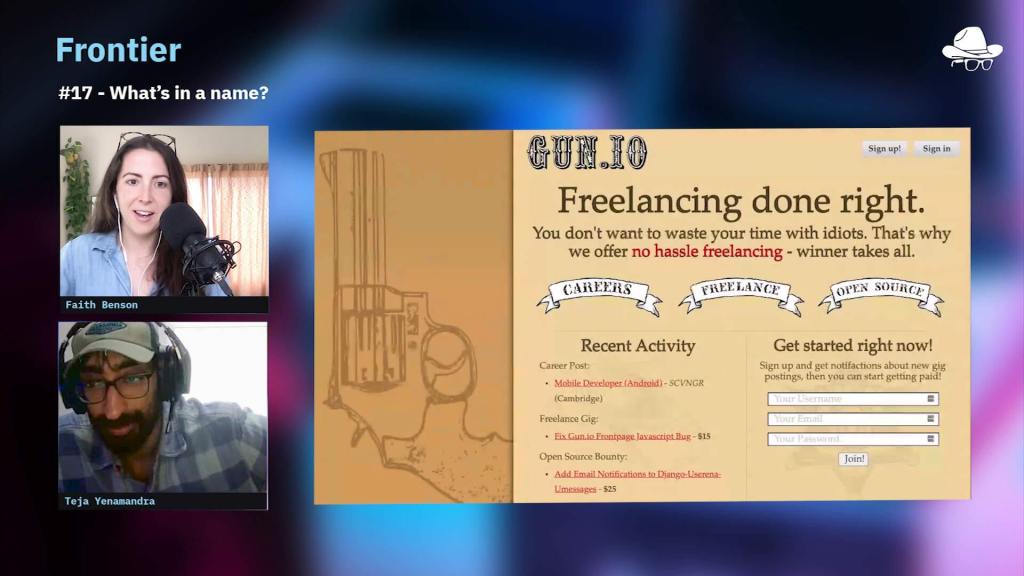
Season 2, Ep. 17 – What’s in a name: The evolution of the Gun.io brand
Every brand goes through the evolution of its own identity, and Gun.io is no different. In this episode, the CEO and Co-founder of Gun.io, Teja Yenamandra, sits down to talk with Faith about Swiss timepieces, capsule wardrobes, and the various stages of our own personal branding throughout the years.
Listen:
Read transcript
Faith (00:05):
I’m starting to record, ‘cause otherwise I forget every single time to press go.
Teja (00:09):
That’s okay. What’s up, Bill?
Faith (00:11):
<Laugh>? What’s up, Bill? He said he appreciates it when we say hi. So—
Teja (00:16):
Shout out the man. Yeah. Hell yeah. We should keep some of this banter in the thing.
Faith (00:22):
Yeah, the banter is good. That’s like the whole point. I’ve been back here in the shed for like a week working. I’m just like using my hotspot, ‘cause they still haven’t run the CAT6. And the outlets are like slowly ceasing to work. <Laugh> Like first it was just the one over here and then it was the light and it’s like slowly working its way around. It’s like Final Destination. And so I’ve moved my desk to like the last functional outlet. So hopefully we survive this.
Teja (00:53):
I love that you call it a desk. It’s the pinnacle of understatement considering how it looks nicer than my house. <Laugh>.
Faith (01:01):
Oh well all this—this is actually like, these cupboards are full of like chicken supplies and gardening supplies and stuff. And then over here I have like my printer and whiteboard and all that, but it’s a multipurpose little garden shed.
Teja (01:16):
I mean, I imagine our listeners are probably readers of the Wayfarer, so I think they’d appreciate—they expect that to be very on-brand for Faith Benson.
Faith (01:26):
<Laugh>. Yes. Yep. Staring out the window at a chicken with a broken leg. Actually, I need to splint it with like a popsicle stick tonight. How was your weekend?
Teja (01:37):
It was pretty good. Trained a lot of upper body, because I hurt my knee in Jiujitsu the last weekend. So I’ve been getting yolked, and—Ok. So I’ve been getting into cooking like a lot. Yeah, it’s been nice. It’s been really fun. So I’ve been making some cool dishes. I made biriani like maybe two weekends ago. This past weekend, I made some lamb korma that I have as leftovers. So I’ve been like—‘cause you know, it’s a whole thing. You need to buy like the right cookware.
Faith (02:12):
You gotta go to the market.
Teja (02:14):
You gotta go to the market. You gotta manage the inventory well, and like at some point, the cost intersection—like there’s a cost intersection. Like, ‘cause cooking, when you first get started out is actually more expensive than ordering in. Right? But then when you get good at it and you figure out what you need and how to do your time, the cost curve comes down. The time curve comes down. ‘Cause now when I make breakfast, I’ll let my dinner— like I’ll marinate my dinner, and it’s like, it’s solid. So I’m on a good run. So yeah, this weekend was a lot of—I had to go to William Sonoma to get some shit that I didn’t have. Got some new cocktail glasses. Yeah, it’s good. I don’t know.
Faith (02:56):
Ah, that’s exciting. There is like totally a like pantry stocking, initial investment of cooking and like cookware investment. Like it’s very hard to do stuff without the appropriate tools. But once you’re there, you’re cruising and you can make anything. Are you making like primarily Indian dishes?
Teja (03:13):
That’s definitely my weak point in cuisine. And I think also the most interesting to cook for somebody. So that’s been an area of focus for me. You know, my steaks are pretty solid. Italian food and pasta I can kind of make. But I would say Indian food’s like a crowd favorite. And also it’s like a part of my tradition that I kind of ignored. So it’s like a way for me to reconnect with my culture and also learn some new things.
Faith (03:46):
Well great. Teja, welcome to the Frontier. Welcome back to the Frontier podcast. (Teja: Thank you.) We’re talking about branding today, which I’m very excited for, because this is <laugh> This is like one of my favorite things to read about and judge about other people. And I feel like I rarely do like a retro of our own. So I’m excited to do this live with you today.
Teja (04:08):
Me too. I love branding. I mean, it’s— in real life, it’s how people show up. It’s how companies tell their story. It’s sick, it’s cool.
Faith (04:19):
What is your favorite rebrand of all time?
Teja (04:22):
The Swiss invented watchmaking. I think that’s right. They were the first to waterproof watches and the whole like—there’s like a big Swiss watchmaking tradition. I think they took a Rolex to Everest along with a Smith watch. Like, you know, they took an Omega to the moon. They were performance pieces and they were originally tools, and the average person could afford a really high-end watch, which was a tool, on an average salary. And then the Japanese basically figured out how to industrialize and mass produce watches using quartz movements and battery driven movements. And so they were able to basically produce watches for like 1/10th of the cost and like 10 times more volume. The Swiss were unable to compete at that middle market level. And so Omega—which is now Swatch group owns Omega and a bunch of other like luxury high-end Swiss brands, Rolex…
And a lot of the Swiss and European watchmaking industry, their strategy was to actually move upmarket, make their watches way more exclusive and almost like an aspirational luxury item to basically corner an aspect of the watchmaking market and I guess the watch buying market, I should say. And like, I’m super into watches. And so like that, to me, was like an incredible adjustment of their strategy, because they knew that they couldn’t compete with the Japanese on scale, even mechanical accuracy of the watches. ‘Cause the quartz watches are way more accurate than the mechanical handmade watches that Rolex and Omega and all these other makers would produce. And so they were like, let’s work with, you know, the James Bond folks to make it like, cool, that Bond was wearing a Rolex or an Omega. Let’s make it like a sign of being like a wealthy kind of gentleman. You know? Now it’s like, that’s what the rappers wear. That’s what a lot of influencers wear. Like a lot of even people in the military—for some reason or another, like they still wear a Rolex or like an Omega. Right? And so like, yeah, it’s gotten this place as like a status symbol when it was not in the past. It was just a tool. And so yeah, that to me, it was just like an incredible rebrand of not just the company, but the whole industry, because you look at the way Rolex sells their watches, the way that Omega sells their watches. It’s like they’re exclusive. It’s hard to buy. You have to make a lot of money to be able to justify a purchase of a nice watch. It’s super fascinating to me. But that’s probably one of my favorite rebrands.
Faith (07:07):
That’s super cool. That’s a very earnest answer. And I was thinking about this today, and I was like, honestly, I love the rebrand of house plants. Like they used to be such a symbol of like creepy, just like weird old hippie house. Like growing up, if I walked into a house and there were a ton of house plants, I’d be like, This place smells weird. Get me outta here, Mom, can you pick me up? And now it’s like, if you don’t have—I mean, like look at me. If you don’t have house plans, it’s like, are you even an adult? But in term—company that I think I’ve enjoyed watching the most, just because I’m an elder millennial like you, is—and usually I don’t watch consumer brands too much, but I’ve loved watching Abercrombie and Fitch’s rebrand. Have you been watching that?
Teja (07:55):
No. What’s been happening? I know what they were.
Faith (07:58):
Right? It’s really—it’s interesting, because it’s a rebrand while maintaining like the ethos of the original brand, in a way. But basically, they’re like, Ok, look, malls are dying obviously, and our whole brand is now taboo. We can’t have half-naked teenagers modeling our clothes who haven’t eaten in three weeks. You know? So they had to figure out like, How do we get our original market back, which is you and I. And so they started creating like clothes that are a little bit higher quality than what we would get at like The Gap or Zara or something, but then marketing it to us in a way that’s like very strategically millennial, which is like, we like to be served very few options. We want the whole—we want the style to be like, created for us, so that like the clothes are very different. The experience of shopping there is very different. But they did it with a very specific demographic in mind, which is elder millennials that don’t know how to be cool. So that one’s been fun. And I will be the first to admit, I have ordered a pair of jeans from Abercrombie & Fitch outside of 2005. So…not proud, but—
Teja (09:20):
No, I mean, I love that. And actually, I remember having a conversation a few years ago where you were talking about how you like to lean into one brand, because the pieces kind of work well together. And I love that. And I started doing that with this one brand. It’s a little pricey, but they’re called Faherty, and they’re on 12 South, actually, here in Nashville. It’s like a very—this shirt’s from them—like they have a very cool kind of almost like casual work wear that’s still professional and like high quality material kind of vibe. And all the pieces work really well together. And it is nice that you can buy style like out of the box and it all fits together. ‘Cause the length needs to be right. Like the silhouette needs to fit, you know what I mean? In the right way together. And so yeah. That’s cool. Will you buy more pieces from Abercrombie & Fitch, or are you waiting to see how this one fits?
Faith (10:23):
TBD. I’ve since started renting clothing, which we could have a whole podcast episode about how awesome that is. But our brand today, I’m gonna walk us through like a visual experience here. This is our current website, our current brand: Gun.io. Teja, how would you describe this?
Teja (10:42):
The feelings that it evokes for me is very futurist. I mean, I don’t know, this may be like self indulgent, but like, we were a part of this. I think it evokes a sense of professionalism. It’s clean. I mean, kudos to you and Steve. It evokes a sense of like, we know what the fuck is up, because we work with companies that are pretty legit. And it evokes a sense of professionalism. Some sort of, I don’t know, like futuristic motif, space cowboy/cowgirl/cow person motif. That’s what we were going for here. Like it evokes all the shit that I’ve superimposed onto us during the design process. So…<laugh>
Faith (11:29):
I don’t know about that. I think this is where brand comes from, right? If we go back, this is the OG site. (Teja: Holy fuck.) And it’s so funny that like, this is such—it’s such a different translation of space cowboy, Wild West, even Gun.io. Like the thing that we’re trying to evoke here is like, ‘We’re hired guns, we got this,’ you know, and it’s like very, obviously the design is very different, but I think the brand story is really similar. Like these guys, if they walked into some saloon in the Wild West, I’d be like ducking under tables. And I feel like that’s kind of where we started, you know?
Teja (12:17):
Yeah. I love this, actually. This was like some legit ass shit. This is good.
Faith (12:22):
Ok, so OG site, we had a jobs board, we had freelance posting, and then what was this? Just like a list of open source that people could contribute to?
Teja (12:35):
Yeah. Yeah. The original ethos of the—
Faith (12:39):
I see open source bounty.
Teja (12:40):
Yeah. The original ethos of the business was like, hey, there are a lot of talented devs that are basically looking for freelance opportunities to sustain their ability to work on things that help all of us, you know, bright open source software, and so that was a core part of our mission in the early days of—I think probably this tech boom that’s lasted a decade or more.
Faith (13:06):
And then—
Teja (13:10):
<Laugh>. Yeah. Yeah. So, ok—a little bit about this. This is a friend of my co-founder, his name is Seth. He represented like the archetype of like, the type of programmer that we were serving. And he was like a real life friend of Rich. And the original business, like, we were basically helping our friends—I mean, mostly Rich’s friends, get connected with companies that we would cold call on Angel List or, you know, market to through our blog on Hacker News or whatever the hell. And so, yeah, we got a lot of flack for this photo. Undue, I think, honestly.
Faith (13:51):
Really?
Teja (13:53):
Honestly, I mean,—I gave a full and sincere apology for it that it, like—we did not understand that it might impact people’s feeling that they were excluded from becoming developers or from participating in the tech ecosystem. Like, we didn’t understand that. (Faith: Yeah.) So we were willing to apologize for that. But I do kind of think it’s like—it’s a joke, you know, and it’s like, this guy did have a beard. It’s like—and if you don’t got a beard, that’s totally ok. Like, you know, it’s fine. You can’t grow a beard.
Faith (14:28):
For everyone who’s like <laugh> If you’re listening live, it’s a dude with a beard and the hero says, “Beards of experience, hire a top developer now.” And it—but it still carries like a lot of— there’s like this torn parchment header up here, top nav and it’s kind of reminiscent of where we started with this kinda Wild West OG internet theme. But that’s funny. I didn’t realize. This is our very first drama as a brand.
Teja (15:08):
This is the first political controversy. I spent probably a whole day on Twitter apologizing <laugh> to people. And it’s funny, because probably one of the best devs in the company, in fact the dude who runs our DevRel function, I’ve never seen him with any facial hair ever. So it’s like—
Faith (15:28):
Ok, moving on from facial hair. We now have, we’ve gotten rid of the torn parchment on the top nav. We have a super clean looking website with a guy in front of a board that’s got, what is that—something behind him that looks formulaic?
Teja (15:49):
Yeah. My screen is blurry, so I can’t see. I think that actually might still be Seth, or it might be a different person. I can’t remember if that was like a stock image or like what. Knowing Rich, I’m like 99% sure it’s not a stock image. I’m like 99% sure it’s not.
Faith (16:09):
That’s amazing.
Teja (16:11):
Yeah. He’s really good about this.
Faith (16:12):
This one feels like it’s a a response to getting flack on this one. Like, we really pulled back on the branding and we’re like, Alright, let’s just do a header that nobody can be mad about, and here’s a picture and—you know, super basic and pro. And we went from that to actually just stripping away pictures of people all together. But the logo stayed the same. So—
Teja (16:45):
This is the move to professionalism. You just got some fucking amorphous hands. Can’t tell whose hands—what race they are, gender, anything like that.
Faith (16:57):
It looked—they’re next to a computer, so like they could hypothetically start coding at any moment.
Teja (17:03):
Yep.
Faith (17:03):
Ok. And then—so this is our website when I first joined. And so we’ve got some really cool custom art. This is actually by a local artist in Nashville who made these scenes for us. And it’s all derived from this like, futuristic, kind of like dystopian world where we’ve got–I don’t know what this is–satellites that are doubling as like launch—like weapons launch. I don’t know, you tell me, Teja.
Teja (17:33):
It’s like a Rorschach test. You see what you wanna see. I think this is what this is supposed to convey, which is like a feeling of like, okay, you’re like on the edge of like doing something sick, and you need people who have been there, who are already doing something cool technically. And so we have access to these people, and they’re doing some crazy shit with balloons and satellites.
Faith (18:01):
Mm-Hmm. <affirmative>. Yeah. I loved this site. And obviously I love our new branding as well, which we can just fast forward across two years. But we went dark mode. Dark mode, but much cleaner. And then, yeah—obviously this is our final iteration today, but it’s so interesting how the thread that ties everything together has been the same, but it’s been interpreted in so many different ways.
Teja (18:32):
That’s so true.
Faith (18:34):
I think what’s interesting to think about as well is like the ethos of the brand, right? So not just like the visual manifestation of how we interpret what Gun.io means, but also like why we exist and who we serve, right? Like we started off with offering bug bounties and now we’re paying people enough to, you know, feed them and their families and buy second homes and all that awesome stuff. It’s just like <laugh>.
Teja (19:10):
Oh it’s—oh, it’s crazy.
Faith (19:12):
Yeah. It’s like, it’s interesting too how like the level of legitness has increased as our designs have become a little bit more legit too, right?
Teja (19:25):
Totally. I mean, the ethos has been consistent, and I think our love for what we do has been consistent. Like it’s—it feels really—feels like deeply meaningful to provide jobs and like create economic opportunity for people that we’ve never met in real life. And then also to help companies like, you know, create the solutions that they wanna create to bring into this world. And that, like, that’s probably been my favorite part of the job. And it’s cool, like, as the company has grown, the means by which we can like depict that visually—you know, basically our first impression has like also gotten, I don’t know, stronger. So our capabilities increased. Like the designs keep getting cooler and more slick and more professional. And I mean, like, also technology’s getting better. Like it’s easier to make a tighter looking website, you know, because of the open source developers actually. Like, that’s also true. Like, it’s ‘cause devs are making it fucking easier to make cool shit. So kudos.
Faith (20:32):
I wonder if there’s any, you know—obviously we chose Gun.io as a name for a reason, and you and I have talked about this in the podcast as well. Have we ever thought about doing like a wholesale rebrand, name change, imagery change, ethos change? Or have we been committed to this forever?
Teja (20:52):
You know, like there have been occasional moments of feedback that we’ve gotten around like, is “Gun” like divisive? Like what does it mean? And you know, we’ve gotten feedback. Maybe it should be like ‘Guns for Hire’ or ‘Hired Guns’ or ‘Hate Gun’…People don’t like guns. And I don’t know, to me, I think if that actually becomes a high priority problem to solve, then we’ve like delivered on our promise of getting every awesome dev a job and like every company the people they need. Like, we’ve actually achieved our vision, ‘cause like if that’s actually the high priority problem, I don’t know <laugh>. So yeah, we’ve gotten feedback. (Faith: Yeah.) But I don’t think we’ve ever seriously considered it. I mean there have been moments where we’re like, it’d be cool to buy gun.com and you know, it would be cool to not have an Indian Ocean domain, but devs know the IO domain. It’s close to our core customer base on the talent side, and in some cases the company side. So it’s not been something that we’ve seriously entertained.
Faith (22:04):
Yeah. And I think the, at the end of the day, we’re still serving the same customer, which are hired guns, right? Developers who are kind of ready to jump into any scenario we think of. Like, we think of Mandalorian a lot when we’re talking about brand internally, right? Like just ready to go. No bullshit. Nobody’s gonna question their decision making. And I think it’s important to keep that kind of at the center of obviously all of our like planning and decision making, but our brand, right? ‘Cause that’s who we’re serving.
Teja (22:40):
Yeah, totally. And you know, for what it’s worth, I don’t think we’ve ever gotten any pushback or feedback from our developer base or our customer base on the brand and the name, like ever. It’s usually been like—I mean the feedback we get is like maybe the flow should be a little bit less cumbersome or something like that. But the feedback we’ve gotten on the brand that’s been like, hey, maybe we should reconsider, it’s like from people who don’t use us as a company, right? Like they— it’s like more of like an intellectual abstraction, you know? Rather than something that they’ve experienced.
Faith (23:15):
Yeah. Yeah. And what’s interesting is like, we know that counter positioning works well in almost all cases, but especially with brand. Like if you can be the thing that’s not this other thing, usually you’ll win at least in some ways. And I think we have a whole—we’re working within a space where we kind of sit in the intersection of a lot of Venn diagrams that are all kind of antiquated industries, right? Like recruiting, no one likes recruiters, talent agency. Like all these things that just like feel stale and old. I feel like that’s why people remember us. ‘Cause they’re like, you don’t have a kind of sanitized website or sanitized brand, that appeals to everybody, right? Like you absolutely are who you are, and it’s evident in everything you do. And I think that’s a strength. And if some people don’t like it, that means that we’re <laugh> probably doing it well.
Teja (24:13):
That it’s working. You know, if the core customer base and the dev base like it, it’s what’s important. You know, I remember Rich told me, he’s like, ‘Dude, I don’t ever want a fucking bootstrap theme with blue boxes on the site.’ And I’m like, ‘Hey bro, I fuckin’ hear you.’ So that’s—and I’m glad that we have stayed true to that. (Faith: We can make it happen.) I mean, we have been making it happen, and I think we will continue to do so.
Faith (24:41):
<Laugh> Well that’s a good way to end. If you’re listening on audio, we’ll throw these screenshots up in show notes, because it is fun to look at. It’s also very fun to look at brands that you admire today in The Wayback Machine, because everybody had a view one of their website, right? So that’s always fun to look at.
Teja (25:00):
Totally.
Faith (25:01):
Talk to us about your favorite branding geniuses, and maybe we’ll continue the conversation. Alright. Teja, thank you so much. This has been fun. We should do it again, maybe later this week when we have another podcast interview.
Teja (25:13):
Alright. Thanks, Faith.
Faith (25:14):
Thanks for listening to the Frontier podcast, powered by Gun.io. We drop two episodes per week. So if you like this episode, be sure to subscribe on your platform of choice and come hang out with us again next week and bring all your internet friends. If you have questions or recommendations, just shoot us a Twitter DM at @thefrontierpod, and we’ll see you next week.
Teja (25:43):
It’s probably just a latency issue. I bet it’s on your end, because I’m on Fiber.
Faith (25:50):
So it’s a hundred percent. I mean, I’m on a hotspot, so definitely on my end. That’s all good. I mean, Bill can edit us so we sound normal.
Faith (26:01):
BilL cAn eDiT us sO wE soUnD n0rMal.~
Hi Bill.
Thanks for editing us.
Watch:
Bonus pics:
